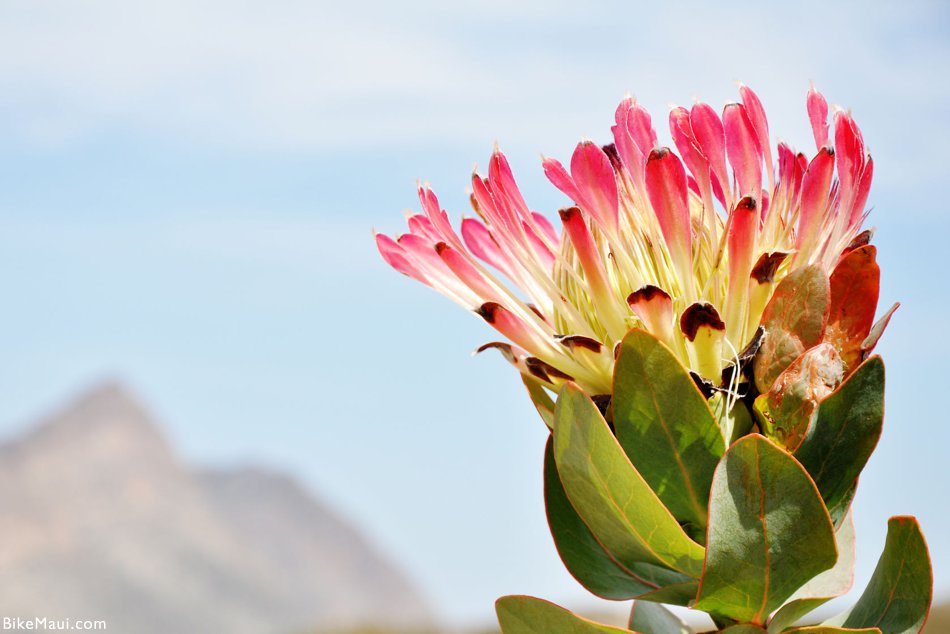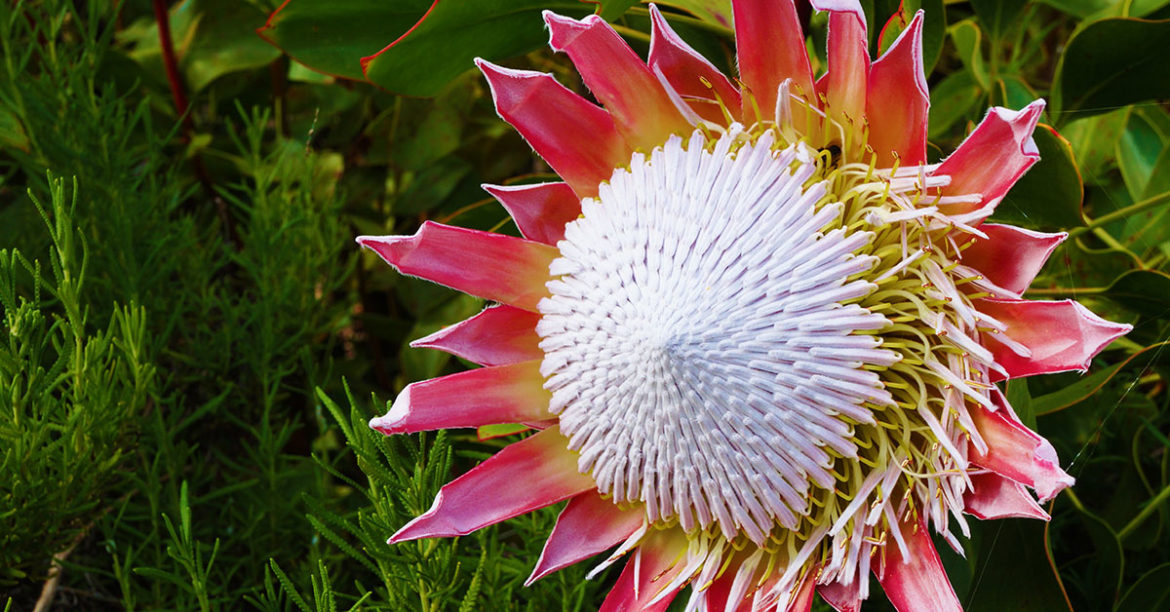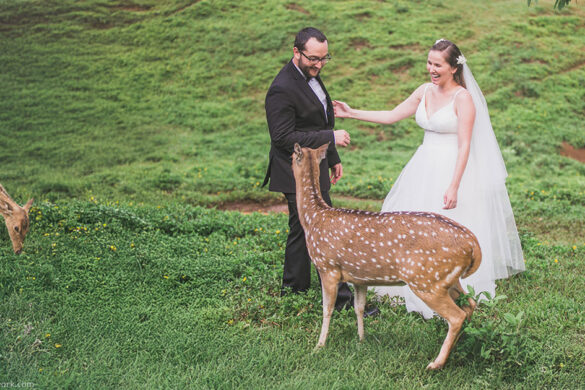To bike down Haleakala is to temporarily exist in another world—a realm where mist rises from the winding roads and pastureland gives way to unparalleled views of Maui’s magnificence around and below. Abundant flora and fauna will undoubtedly catch your eye as you zoom by, from jacaranda trees in wild, pastel bloom to the bristly silversword on the volcano’s moonscaped slopes. But whether you’re gliding down the summit or driving up, stay on the lookout for one of Hawaii’s most unusual and outrageous flowers: The protea.
Known for their technicolor hues, crowned heads, and rare petals—from spiky and slender to stems that evoke sea creatures—it’s no wonder that the stunning and scintillating protea is frequently associated with valor and diversity.
Rising towards the sun on the slopes of Kula, they stand as a sign of nature’s bold and sundry beauty, referred by some botanists quite simply as “The Flower That Can Change Its Form.” They’re also emblematic of Mother Nature’s sheer steadfastness: With origins dating back 300 million years—where it once grew on the supercontinent Gondwanaland before the landmass divided—proteas are one of the oldest flowers on Earth.
Myths surround this splendid, ancient stem.
The King of Modern Botany—a Swedish chap named Carl Linnaeus who was also renowned for his works in medicine and zoology—christened the protea plant after a Greek legend. According to lore, Poseidon—the Olympic God of the Sea and famed Earth Shaker—had a mighty, all-seeing god of a son named Proteus, who possessed the power to foretell the future. To disguise himself from the crowds of people searching for insights, the Old Man of the Sea (as Homer once called him) would frequently alter his appearance at will. From this legend, the word “protean” arrived. And such is the strength of the protea bloom: Mutable and adaptable, it assumes otherworldly forms—coming in with an astounding 1,600 varieties.

Its roots travel far:
Protea plants hail from the shores of South Africa and the flats of Cape Town, where the King Protea (which grows to an impressive 3 feet tall) is celebrated as the country’s national symbol and appears on passports, birth certificates, and the R5 coin—not to mention making a star appearance in cultural ceremonies and social gatherings, while also reigning as the name of South Africa’s national cricket team. With its proclivity for dryer climates, this “sugarbush” also thrives in Australia, New Zealand, California, and Hawaii—and ranks as the only genus that’s naturally common to both South Africa and Australia. Thank the vastness of these landscapes for the remarkable variety of the protea plant: Given the terrific isolation of these regions, the flora is allowed to evolve over time into separate species.

Bats and sugarbirds are wild about these cheeky stems, while bees in South Africa use the flower’s resin to seal their nests.
Over the years, the protea plant has also been tapped for a variety of medicinal uses. As far back as 1672, the honey of protea plants—which is far ampler after a good flood of rain—was distilled and boiled until it took on the hue and consistency of cough syrup, for which it was commonly used. With nectar that supposedly aided stomach ulcers, protea honey peaked as a staple in medicine cabinets in the 1800s before the cultivation of its healing properties was largely discontinued.

Reproduction of this ferocious flower relies on brush fires, where those that act as reseeders are killed by flames after releasing seeds for regeneration, while resprouters possess buds that survive fires and then regrow from underground stems.
Sharing physical characteristics with artichokes, this is one sturdy bud, surviving and thriving through droughts and sub-tropical climes. They fancy sandy loam and open soil and have recently made a splash as a trendy addition to wedding bouquets around the world.

This may not be the island of Pharos on the Nile Delta, but Upcountry Maui’s rich volcanic soil and cooler temps serve these stately blossoms well.
Consider their ability to thrive quite a feat: prior to human settlement, the Hawaiian Islands were slow to see the cultivation of plant and animal life, witnessing the survival of a single plant once every 90,000 or so years. Famed for their hardy nature, proteas first arrived in the Hawaiian Islands with Polynesian voyagers who brought them aboard ships teeming with taro, mangoes, and breadfruit before commercial farming began in the 1970s. At one point, there were more than 50 statewide protea farms, including lava flows on Hawaii that had been bulldozed for harvests; one of the first commercial blooms on the Big Island sold for a quarter. Today, approximately 27 farms are found around the islands, with nearly all of them family-owned or operated.

Colin Lennox—a renowned agriculture expert—is credited as one of the first successful growers on Maui, ultimately producing two startling hybrids on his Cloudbank nursery in Kula.
He shared the spotlight with Florida native Phillip Eugene Parvin, the former superintendent of the University of Hawaii Agricultural Experiment and the “Father of the Hawaiian Protea Industry.” During his tenure, Parvin extended the flower’s vase life, implemented ways to make it a valuable crop, and hybridized its beauty—all while counseling the founder of Proteas of Hawaii and his good friend, Gordon Dotty. Six years before Parvin’s death, the “Phil Parvin” protea made its debut. Now, Maui is home to a small but significant smattering of spectacular farms, from Kula’s No Ka Oi Protea Farm and Makawao’s Anuhea Flowers to Dotty’s own Proteas of Hawaii.

Peer closer at the bloom and you might be able to see that proteas are actually a group of individual flowers that are tightly united on a rounded base.
Much like its namesake, this versatile flower has a number of dazzling forms, from the alienesque Vanessa and the bright red Flame Giant to the vivid yellow belle known as Banksia. But the flirtiest of all might be the aptly named Duchess, which flaunts petals so alluring and ornate they resemble feathers. And those oh-so-prevalent boxes of chocolate-covered gems in stores around Hawaii? Praise the protea plant: Macadamia nuts hail from trees within the same genus. Modern family, indeed. Or, rather, just another sign of Hawaii’s mixed-pot, aloha charm.









1 comment
They are beautiful.